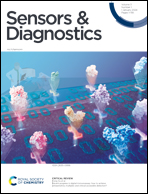Turn-off fluorescence of imidazole-based sensor probe for mercury ions†
Abstract
A new highly selective and sensitive fluorescent probe, 5 (2-(4-(1,3-dithian-2-yl)phenyl)-4,5-diphenyl-1H-imidazole), was developed for Hg2+ ion with colorimetric and fluorimetric behavior in organic semi-aqueous solutions. A significant color change from strong cyan blue to weak blue can be observed with probe 5 in association with Hg2+-promoted deprotection of thioacetals. Fluorescent probe 5 can detect quite low levels (5.3 nM) of Hg2+ ions. However, we carried out an NMR titration experiment and DFT analysis to characterize the sensor probe 5 with Hg2+ ion based on the intramolecular charge transfer mechanism. Furthermore, sensor probe 5 responded quickly across a wide pH range. Most importantly, it could be utilized for excellent selective detection and bio-imaging of Hg2+ ion in the E. coli cells, as well as Whatman filter paper-based test strips.



 Please wait while we load your content...
Please wait while we load your content...